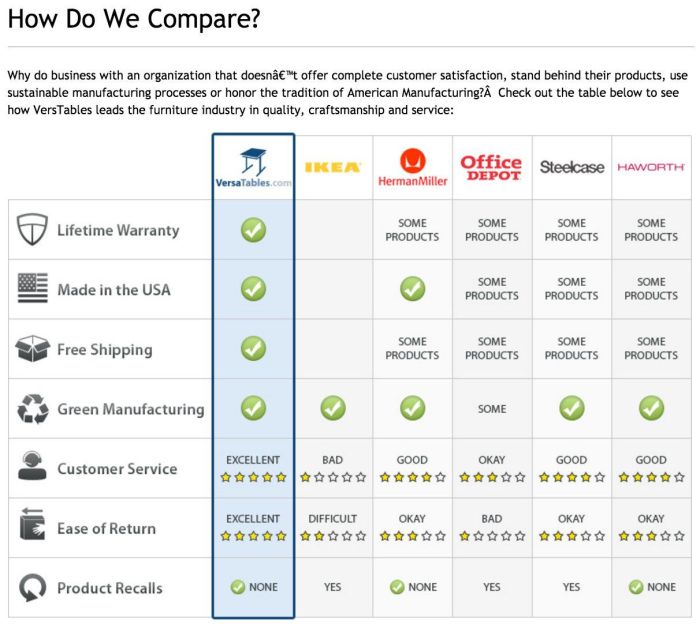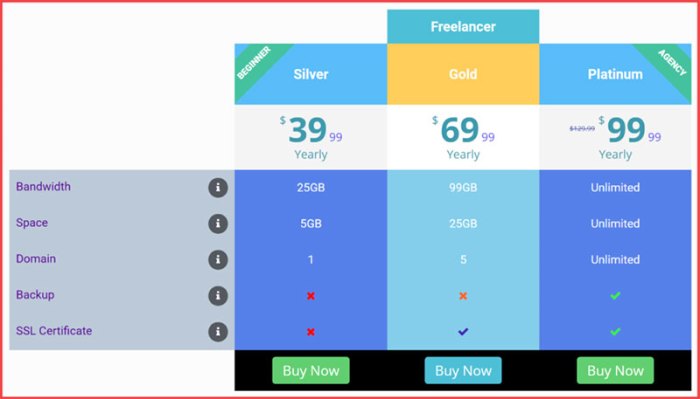Creating Product Comparison Pages introduces a dynamic way to enhance user experience and drive sales. Dive into the world of product comparisons with this comprehensive guide filled with tips and strategies for success.
Introduction to Product Comparison Pages
Product comparison pages are essential tools for online shoppers to make informed purchasing decisions. These pages provide a side-by-side analysis of different products, highlighting their key features, specifications, and prices.
The Purpose of Creating Product Comparison Pages
Product comparison pages serve as a valuable resource for consumers looking to compare multiple products before making a final decision. By presenting information in a clear and concise manner, these pages help users easily identify the best product that suits their needs.
The Benefits of Having Product Comparison Pages
- Allows for quick and efficient comparison of products
- Helps users make informed decisions based on specific criteria
- Saves time by eliminating the need to visit multiple websites
- Increases user engagement and retention on the website
Target Audience for Product Comparison Pages
The target audience for product comparison pages includes online shoppers, tech-savvy consumers, and individuals seeking to make well-informed purchasing decisions. These pages cater to those who value research and comparison shopping before making a final purchase.
Designing Product Tables for Comparison
When it comes to creating visually appealing tables for product comparisons, there are a few key guidelines to keep in mind. First and foremost, you want to ensure that the design is clean and easy to read. This means using a consistent layout, clear headings, and a color scheme that is easy on the eyes.
Organizing Information Effectively, Creating Product Comparison Pages
To organize information effectively within the comparison tables, consider grouping similar features together. This could mean categorizing by price, size, performance, or any other relevant criteria. By doing this, you make it easier for consumers to quickly compare different products side by side.
- Use bullet points or checkmarks to highlight key features
- Include images of the products to enhance visual appeal
- Consider using color coding to differentiate between products or highlight important information
- Make sure to include a clear and concise description of each product
Importance of Including Key Features and Specifications
Including key features and specifications in the comparison tables is crucial for helping consumers make informed decisions. By providing this information upfront, you empower customers to quickly identify which product best fits their needs. Whether it’s the battery life of a laptop, the resolution of a camera, or the size of a smartphone screen, these details can make a big difference in the purchasing decision.
Remember, the more detailed and accurate the information, the better equipped consumers will be to choose the right product for them.
Writing Compelling Product Descriptions: Creating Product Comparison Pages
Crafting engaging product descriptions is crucial when creating comparison pages. Each item in the comparison should have a unique and captivating description to grab the attention of potential buyers. By using clear and concise language, you can effectively communicate the key features and benefits of the product, helping consumers make informed decisions.
Significance of Clear and Concise Language
Using clear and concise language in product descriptions is essential for several reasons. First, it helps consumers quickly understand the main features of the product without getting lost in unnecessary details. Second, it allows for easy comparison between different products, enabling shoppers to make a more informed choice. Lastly, clear and concise descriptions can increase trust and credibility, making it more likely for customers to make a purchase.
- Highlight the unique selling points of the product
- Focus on benefits rather than just features
- Use descriptive language to paint a vivid picture for the reader
- Avoid jargon or technical terms that may confuse the audience
Examples of Compelling Product Descriptions
1. “Experience the ultimate comfort with our memory foam mattress, designed to provide unparalleled support and pressure relief for a restful night’s sleep.”
2. “Unleash your creativity with our high-performance DSLR camera, featuring advanced technology for stunning, professional-quality photos and videos.”
3. “Step up your fitness game with our smartwatch, equipped with fitness tracking capabilities and a sleek design that fits seamlessly into your active lifestyle.”
4. “Indulge in luxury with our handcrafted leather handbag, meticulously designed for both style and functionality, making a statement wherever you go.”
Remember, the goal of a compelling product description is to entice the consumer and drive conversions. By focusing on the unique benefits and using clear language, you can effectively showcase the value of each product in the comparison.
Adding Visual Elements
Adding visual elements to product comparison pages can greatly enhance the user experience and make the information more engaging and easy to understand. Visual elements can include images, icons, and infographics that help users compare products at a glance. Let’s dive into how these elements can be used effectively.
Types of Visual Elements
- Images: High-quality images of products can provide a clear visual representation of each item being compared. This can help users quickly identify key features and differences between products.
- Icons: Using icons to represent different product features or specifications can make the comparison process more intuitive and visually appealing. Icons are often used to indicate things like battery life, connectivity options, or warranty information.
- Infographics: Infographics are visual representations of information, data, or knowledge that can be used to present complex information in a clear and concise manner. They can help users understand comparisons more easily by breaking down information into digestible chunks.
Visual Hierarchy and User Attention
Visual hierarchy plays a crucial role in guiding users’ attention on comparison pages. By strategically placing visual elements such as images, icons, and infographics, you can draw users’ eyes to the most important information first. For example, using larger images or bold icons for standout features can help users focus on key differences between products. Additionally, organizing visual elements in a logical and structured way can make it easier for users to navigate the comparison page and find the information they are looking for.
Implementing User-Friendly Filters

Incorporating user-friendly filters is crucial for helping users narrow down their product choices quickly and efficiently. By providing filter options, you can streamline the decision-making process and enhance the overall user experience on comparison pages.
Designing User-Friendly Filter Options
When designing filter options for comparison pages, it’s essential to keep the following best practices in mind:
- Provide clear and relevant filter categories based on the products being compared.
- Use intuitive design elements such as dropdown menus, checkboxes, or sliders for easy selection.
- Allow users to apply multiple filters simultaneously to refine their search results.
- Include a search bar for users to quickly find specific filter options.
- Display the selected filters prominently to keep users informed of their choices.
Improving User Experience and Conversions
By implementing user-friendly filters on comparison pages, you can significantly improve the overall user experience and increase conversions:
- Enhanced Navigation: Filters make it easier for users to find products that meet their specific requirements, reducing the time spent searching.
- Increased Engagement: Users are more likely to interact with comparison pages that offer convenient filter options, leading to higher engagement rates.
- Boosted Conversions: By helping users find the right products efficiently, user-friendly filters can increase conversion rates and drive sales.
- Improved Customer Satisfaction: Providing a seamless filtering experience enhances customer satisfaction and encourages repeat visits.
Including Customer Reviews and Ratings

Customer reviews and ratings play a crucial role in helping potential buyers make informed decisions when comparing products. They provide valuable insights into the actual user experience and satisfaction level, which can greatly influence purchasing choices.
Benefits of Showcasing Customer Reviews and Ratings
- Builds Trust: Authentic feedback from customers helps build credibility and trust in the products being compared.
- Provides Social Proof: Positive reviews and high ratings serve as social proof, reassuring other buyers about the quality and performance of the products.
- Highlights Key Features: Customer reviews often highlight specific features or benefits that may not be evident in the product descriptions, giving potential buyers a more comprehensive understanding.
Strategies for Collecting and Displaying Authentic Customer Feedback
- Encourage Reviews: Prompt satisfied customers to leave reviews by sending follow-up emails or offering incentives.
- Verify Reviews: Implement a verification process to ensure that the reviews are genuine and from real customers.
- Respond to Feedback: Address negative reviews promptly and professionally to show that you value customer feedback.
Examples of How Customer Reviews Influence Purchasing Decisions
- A product with numerous positive reviews and high ratings is more likely to be chosen over a similar product with no feedback.
- Negative reviews highlighting specific issues may deter potential buyers from purchasing a product, leading them to explore other options.
- Personal anecdotes and experiences shared in reviews can resonate with potential buyers, influencing their emotional connection to the product.






